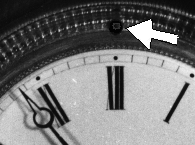 This enables
the clock to be regulated in situ, without the necessity for opening
the back, removing the pendulum, and adjusting the rating nut.
This enables
the clock to be regulated in situ, without the necessity for opening
the back, removing the pendulum, and adjusting the rating nut. This enables
the clock to be regulated in situ, without the necessity for opening
the back, removing the pendulum, and adjusting the rating nut.
This enables
the clock to be regulated in situ, without the necessity for opening
the back, removing the pendulum, and adjusting the rating nut.
Getting at the pendulum can be a difficult task with marble clocks, or where the mantelpiece or shelf is narrow.
Description :
Behind the regulating square on the dial, (arrowed in the photograph), the regulating arbor ends with a small brass star-toothed gear that engages at a right angle with an upright larger gear wheel having a threaded brass shaft held in the suspension block. When this is turned, via the square of the regulating arbor, a small threaded block with a fine split moves up and down the stationary suspension spring thereby effectively lengthening, or shortening, the pendulum drop. With the pendulum drop fractionally shorter the clock will run faster. Longer, the clock will run slower.
With a double-ended key, the smaller end used to adjust the regulating arbor thus: clockwise to gain, anticlockwise to lose. It is important never to turn the regulating arbor more than a fraction (one quarter turn) for each regulating session. Make each adjustment a small one, set the hands to time, wait 24 hours, note the gain or loss then make a further small adjustment if necessary.
It is better to have patience and regulate your clock by degrees. Indiscriminate turning of the regulating arbor may result in breaking the suspension spring.
Remember, one turn of the regulating square could represent several minutes gain or loss in the course of one week !
It is important not to mangle the end of the arbor with pliers. Take an impression of the square with a piece of paper, and use this as a guide to obtain the appropriate size pocket watch key.
If we think about the likely age of these antique French clocks, in the mid-nineteenth century it is possible that they were not at first provided with double-ended keys. Key-wound pocket watches were ubiquitous then, and it is a fair bet to imagine that any regulating to be done was effected with a handy pocket watch key.
Copyright ©IAN PARTRIDGE 1997